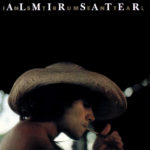
Something so simple as an album of 10-string viola caipira instrumentals shouldn’t sound so impressive, but leave it to Campo Grande native Almir Sater to make you rethink a whole lot of something. This release, Instrumental, was more than just a musical document of some brief musical sojourn, it was a massive peek into the dreamy rural music of the Brazilian central region, specifically his province, Mato Grosso. What little is known (at least outside of Brazil) is how deep this collection of Brazilian country songs went into regional styles we scarcely encounter as part of Brazil’s larger, internal musical lineage.
Pastoral, experimental, and supremely inviting, it’s the rare sort of record that would fail if it tried to sound like something other than where it came from. The sinewy, chiming, viola caipira truly afforded Almir a way to tie something unique together. Imagine Dylan’s country pastorale Pat Garrett and Billy the Kid mixing with the breezy guitar impressionism of Balearic master Joan Bibiloni, then you sorta get to the sound of Almir’s Instrumental.
Almir Sater began his career as a rural hillbilly-esque troubadour influenced by the music of Bob Dylan and Joan Baez. Adopting the cheap, dual course, 10-string viola of the poor as his instrument, allowed Almir to explore the regional music, specifically the sertaneja. Then translating that initial study into an attempt to mix Americana with Brazilian rural regional styles found him writing for Santos heavy hitter Renato Teixeira. His debut album found him at the middle ground of American country and MPB-style hippy psychedelia. A sophomore release flew by with little regard from his country. 1986’s Cria a mix of pop and electronics with his country roots sparked some interest but artistically it wasn’t what he looked for. Withdrawn, Almir formed an organization he’d dub the “Comitiva Esperança” to uncover the music and creative customs of his people.
For three months Almir travelled through Mato Grosso’s landlocked rivers, plains, and swamplands discovering and researching forgotten styles like cururu, chamamé, and arrasta-pé. It was this unique music which drew from native Brazilian indios and surrounding rural quotidian communities in Argentina and Peru that allowed him to try to experiment with a new something. A visual documentary was released of his time then, but once he headed back into a recording studio, Almir would reflect back and start to reassemble what he learned into a musical tome. Using instruments like berimbau and zither, instruments not common in his own region’s sertaneja music, he started to paint edges and intriguing complexities into this newly acquired music. A young man, with nothing to lose, he transformed iconic, regional songs like “Corumba” by Guilherme Rondon and “Rio de Lágrimas” by Tião Carreiro into fascinating musical ruminations, via deconstruction and restructuring.
Is that a tape-reversed caipira jamming with a viola in “…e de Mina prá Riba”? How wonderful is that pointillist banjo and guitar duet in “Benzinho”? How about that bit of minimal beauty in “Vinheta do Capeta”?Those are the small wonders that speak of a fourth world music that can sometimes be much closer than you think.
